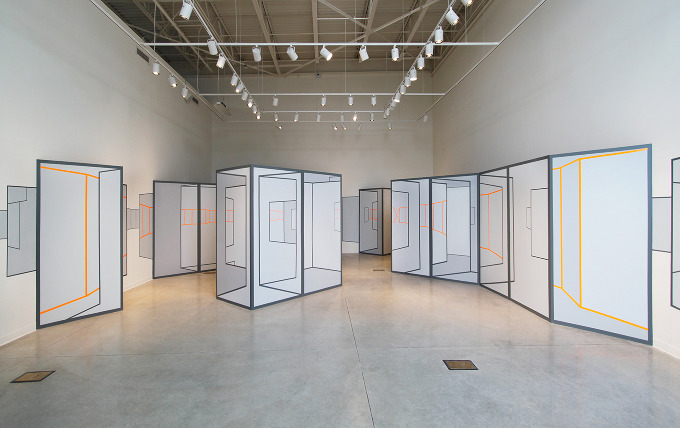Gilley, Damien. Masterplexed at Linfield College. Individual Artist Fellow, Oregon Arts Commission. 2011.
Originally published June, 2011
Damien Gilley is best known for his large scale, architectural wall drawings, those in which he brings tracings of the outside in and those in which his drawings comment on the space in which they’re housed. His “Keller Fortress” (2008) installed at WorkSound gallery was a black light painting of the outlined forms of Portland’s Keller Fountain. Executed in fluorescent tape on the walls, it had the appearance of a vintage digital abstraction, putting the viewer into a vintage video game. His installations for the 2010 Portland Biennial and at galleryHOMELAND commented on the structures in the building, riffing off architectural features like railings, moldings, or doorways, but also created a hint of the space beyond with invented landscapes that appear barren by way of their abbreviation. Gilley says that for HOMELAND, “I was also commenting on the industrial nature of the location, talking about an ambiguity in those industrial areas, they fall apart, they’re popular, they fall apart, they get repopulated and built up again.”
One throughline of Gilley’s work is an effort to depict or create visual references of how people can look at architecture and space that refers to our rapidly evolving visual sense. “We’re becoming so used to navigating through computers through windows, layering them, layering information. It’s influencing how we look at ideas of space, at how we navigate in space, and it’s influencing architecture,” Gilley says. “I am trying to connect static architecture and static space to the digital world which is always changing. I’m trying to find out how we can visually make the connection.
“Some people think, in the future, everything’s going to be video monitors and lasers. I am looking at something more subtle, at the shifting idea of navigation changing how architecture lays out, how we think things should flow, in breaking down ideas of building a city, a building. A good example of someone really doing this is Zaha Hadid.”
But Gilley is not only concerned with the very serious interplay with the digital and the real space, he has a sense of humor as well. He points to his recent installation, “Masterplex” (2010) at Linfield College commenting in a tongue in cheek way on the “worlds” of vintage video games. These low end virtual worlds like that of the game Battlezone, were once state of the art eliciting oohs and ahs and now are kind of a visual joke. “Masterplex is trying to illuminate the disconnection between perfect digital worlds and our own. I don’t believe in a super hyper techno future. I don’t want that and I don’t think that’s going to be the way the world will be.”
Gilley’s most recent and spectacular project, “Re/Activate” (2010) was an installation that filled the Wieden Kennedy lobby gallery. Gilley’s wall drawings created wall and recess and exterior, while the futuristic structures he created on the walls also grew out into the space in outlined forms of unfinished wood and amber plexiglass. Slightly off vertical, framed structures leaned as doorways or future walls, framing the spaces and forms beyond while transparent amber panels both colored the view and arrested the eye at their surfaces. It was an installation that even more than most, begged to be walked through as the view was complex and rewarding from every angle and every location within the installation. In collaboration with Jordan Tull, Gilley created much of the work on-site. “I’m interested in limiting my choices when building. I had been thinking about prototyping, making things that could be produced with little variations over and over,” Gilley says. So he used mostly what he called “Home Depot” materials, simple and straightforward. “We did a lot of this on site. It became an exercise in setting up a processed-based creation based on the material. We began by bisecting the sheets of plexiglass on the diagonal from corner to other side center. That gave us a 14 degrees angle which became our jumping off point throughout the space.”
Among permanent installations of his work, Gilley’s “Incomplete Field Guide for Time Travel” is installed in PSU’s new recreation center. Of cut aluminum, Incomplete Field Guide records and responds to the surrounding architecture, particularly of the university’s plazas and walkways. And Gilley just finished a commission for the entryway of the Clinton Condominiums with a large wall painting/drawing and a smaller piece that’s half laser cut, half graphite drawing.
Gilley’s goal for the summer is to teach less (he currently teaches at PNCA, PCC, and the Art Institute) and get into the studio in research mode in preparation for a show in April next year. After five major installations in 2010, he’s earned a little woodshedding time.
damiengilley.com
Courtesy of The Oregon Arts Commission.
Artist Credit: Damien Gilley
Exhibition: Oregon Arts Commission Fellows
